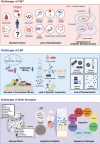Gut microbiome therapy: fecal microbiota transplantation vs live biotherapeutic products
- PMID: 39377231
- PMCID: PMC11469438
- DOI: 10.1080/19490976.2024.2412376
Gut microbiome therapy: fecal microbiota transplantation vs live biotherapeutic products
Abstract
The human intestine hosts a complex ecosystem of various microorganisms, collectively known as the gut microbiome, which significantly impacts human health. Disruptions in the gut microbiome are linked to various disorders, including gastrointestinal diseases, such as Clostridioides difficile infection and inflammatory bowel disease, as well as metabolic, neurological, oncologic conditions. Fecal microbiota transplantation (FMT) and live biotherapeutic products (LBPs) have emerged as prospective therapeutic procedures to restore microbial and metabolic balance in the gut. This review assesses the latest advancements, challenges, and therapeutic efficacy of FMT and LBPs, highlighting the need for standardization, safety, and long-term evaluation to optimize their clinical application.
Keywords: CDI; FMT; Gut microbiome; IBD; LBP; cancer; dysbiosis; metabolic disorders; neurological disorders.
Conflict of interest statement
No potential conflict of interest was reported by the author(s).
Figures
References
-
- Milani C, Duranti S, Bottacini F, Casey E, Turroni F, Mahony J, Belzer C, Delgado Palacio S, Arboleya Montes S, Mancabelli L, et al. The first microbial colonizers of the human gut: composition, activities, and health implications of the infant gut microbiota. Microbiol Mol Biol Rev. 2017;81(4):81. doi:10.1128/MMBR.00036-17. - DOI - PMC - PubMed
Publication types
MeSH terms
Substances
LinkOut - more resources
Full Text Sources
Miscellaneous


